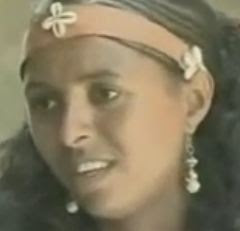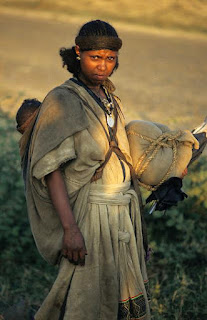Mythologies of the Agaw/Agew/Agau Peoples
The Agaw or Agew (Ge'ez: አገው Agäw, modern Agew) are a Cushitic ethnic group native to the northern highlands of Ethiopia and neighboring Eritrea. They speak the Agaw languages, also known as the Central Cushitic languages, which belong to the Cushitic branch of the Afroasiatic language family, and are therefore closely related to peoples speaking other Cushitic languages. The Agaw peoples in general were historically noted by travelers and outside observers to have practiced what some described as a “Hebraic religion”, though some practiced Ethiopian Orthodoxy, and many were Beta Israel Jews. Thousands of Agaw Beta Israel converted to Christianity in the 19th and early 20th century (both voluntarily and forcibly), becoming the Falash Mura, though many are now returning to Judaism.
The Qemant (also known as western Agaws) are a small Cushitic ethnic group in northwestern Ethiopia, specifically in Gondar, Amhara Region. The Qemant people traditionally practiced an early Pagan-Hebraic religion, however most members of the Qemant are followers of the Ethiopian Orthodox Church. Despite their historic relationship, they should not be confused with the Beta Israel. The ethnicity's population is reported to be 172,000, according to the 1994 national census; the latest available national census, the one performed in 2007, does not list them as a separate group. However, only 1,625 people still speak Qimant, and it is considered endangered, as most children speak Amharic; likewise, adherence to the traditional religion has dropped substantially, as most of the population has converted to Christianity. Converts often consider themselves to be Amharas.
The Agaw or Agew are a pan-ethnic identity native to the northern highlands of Ethiopia and neighboring Eritrea. They speak the Agaw languages, which belong to the Cushitic branch of the Afroasiatic language family, and are therefore linguistically closest related to peoples speaking other Cushitic languages. The Agaw peoples in general were historically noted by travelers and outside observers to have practiced what some described as a “Hebraic religion”, though some practiced Ethiopian Orthodoxy, and many were Beta Israel Jews. A small minority have adopted Islam in the last few centuries. Thousands of Agaw Beta Israel converted to Christianity in the 19th and early 20th century (both voluntarily and forcibly), becoming the Falash Mura, though many are now returning to Judaism. The Agaw are perhaps first mentioned in the third-century Monumentum Adulitanum, an Aksumite inscription recorded by Cosmas Indicopleustes in the sixth century. The inscription refers to a people called "Athagaus" (or Athagaous), perhaps from ʿAd Agaw, meaning "sons of Agaw." The Athagaous first turn up as one of the peoples conquered by the unknown king who inscribed the Monumentum Adulitanum. The Agaw are later mentioned in an inscription of the fourth century emperor Ezana of Axum and the sixth-century emperor Kaleb of Axum. Based on this evidence, a number of experts embrace a theory first stated by Edward Ullendorff and Carlo Conti Rossini that they are the original inhabitants of much of the northern Ethiopian Highlands, and were either forced out of their original settlements or assimilated by Semitic-speaking Tigrayans, Amharas and Tigrinyas. Cosmas Indicopleustes also noted in his Christian Topography that a major gold trade route passed through the region "Agau". The area referred to seems to be an area east of the Tekezé River and just south of the Semien Mountains, perhaps around Lake Tana.
The Agaw peoples are the principal, original, seed-agropastoralist inhabitants now enclaved across north-central Ethiopia and Eritrea. They once covered a contiguous territory in this region. About 523 C.E., visiting Greek, Cosmas, noted a monument at Adulis mentioned the Agaw and that the Aksumites exchanged oxen, iron, and salt for gold in the territory of some Agaw. At one time, all Agaw spoke languages of the Central Cushitic subbranch of the Cushitic branch of the Afroasiatic language family. Today, some persons identifying themselves as a particular kind of Agaw speak only Amharic, or Tigrinya, or Tigre all of the (Ethio)Semitic branch of Afroasiatic. Today, most Agaw are Ethiopian Orthodox Christians; some are Protestants; among the Bilin Agaw, most are Muslims. Qemant speaking and not speaking Qemant totaled 172,291 in the 1994 census. In 2019 this number is larger.
The Awi Agew is one of the most ancient inhabitants of the northern and central highland plateau of Ethiopia. They occupied most of this plateau until the seventeenth century but have been displaced or absorbed over most of this region by the Semitic-speaking peoples. Horses were probably introduced into Ethiopia from the Nile valley during the second half of the second millennium B.C. As the Agew are one of the early inhabitants of the aforementioned region of Ethiopia, their early introduction with horse breeding and training is noticeable, as they did in the area of early plant domestication. Gradually they learned to breed donkey with horse to produce mule, which is outstanding cultural creativity. Agew Meder (now Awi Zone) in Gojjam is also noted for its horse plow culture and long-aged horse riders association. However, there is no comprehensive study undertaken on the history of Awi Agew horse culture. This paper, based on published and unpublished sources and oral accounts, attempted to fill this gap by exploring the place of ancient Awi Agew people in the breeding and training of horses, investigating the beginning of their horse plow culture and looking into the history of Agew Horse Riders Association.
- The Agaw/Agew/Agau are an ethnic group indigenous to East Africa, inhabiting both Ethiopia and Eritrea. Today, there are five main Agaw subgroups: Xamta, Awi, Qemant, Falasha, and Bilen (Eritrea). The Xamta reside in the Wag Hemra Zone (Sekota), Lasta, Tembein and Abergele. The Awi reside in Southwestern Gojjam. The Qemant reside in Western and Northern Gondar. The Falashas formerly lived in Northeastern Gondar; however, most have now migrated to Israel, and the Bilen primarily reside in Central Eritrea. It’s important to note that historically the Agaw have a lot more subgroups/clans within them. While there might be different origin stories for the different Agaw subgroups, a commonly known origin story comes from the Awi, the Agaw of Agawmidir and Metekkel, modern-day Benshangul-Gumuz, (formerly parts of the Gojam province). The Awi tradition states their ancestors came from seven brothers originally from Lasta/Wag area, currently in Wollo, and constituted what is known as the LaNeta Awiya or the ‘Seven House Agaw” (Sebat-Bet Agaw). The seven houses are named after the seven brothers: Banja, Ankasha, Kwakwra, Chara, Metekkel, Zigem, and Azena, and there are other minor groups like Tumha, Dangizh (Dangla), Bil (Belaya), and Gwagwsa who are said to be descendants of the original seven. All the names are now administrative districts or subdistricts in Ethiopia, such as Metekel.
The Awi people are an ethnic group in Ethiopia and are one of the Agaw peoples. The Awi live in Agew Awi Zone west of Mirab Gojjam and have a few communities in the Metekel Zone of the Benishangul-Gumuz Region. The Awi people are composed of seven subgroups, called Ankäša, Azäna, Chara, Qʷaqura, Banʤa, Zigän and Mätäkäl (አንከሻ ፣ አዛና ፣ ጫራ ፣ ቋቁራ ፣ ባንጃ ፣ ዚገን ፣ and መተከል). All Awi groups are classified to the Agaw line (አገው). These Awi mainly live in the Agäw Awi Zone located central Gojjam (Amhara Region), whereas small numbers of Awi groups as well reside in Mätäkäl Zone, neighboring Benishangul-Gumuz Region.
The Qemant (also known as western Agaws) are a small ethnic group in northwestern Ethiopia specifically in Gondar, Amhara Region. The Qemant people traditionally practiced an early Pagan-Hebraic religion, however most members of the Qemant are followers of the Ethiopian Orthodox Church. Despite their historic relationship, they should not be confused with the Beta Israel. The ethnicity's population is reported to be 172,000, according to the 1994 national census; the latest available national census, the one performed in 2007, does not list them as a separate group. However, only 1,625 people still speak Qimant, and it is considered endangered, as most children speak Amharic; likewise, adherence to the traditional religion has dropped substantially, as most of the population has converted to Christianity. Converts often consider themselves to be Amharas. The Qemant live in an area traditionally called Qwara, along an axis stretching from Ayikel in Chilga woreda to Kirakir and north to Lake Tana in the woredas of Lay Armachiho. Most remaining speakers of the language are near Ayikel, about 40 miles (64 km) west of Gondar. They are mainly farmers. The Qemant are divided into two patrilineal moieties, the Keber and the Yetanti; the Keber is higher in rank. A traditional Qemant can only marry a member of the other moiety, so, while the moieties are exogamous, Qemant society as a whole is endogamous.
The Agaw are perhaps first mentioned in the 3rd-century AD Aksumite inscription recorded by Cosmas Indicopleustes in the 6th century. The inscription refers to a people called “Athagaus” (or Athagaous), perhaps from Ad Agaw, meaning “sons of Agaw.”[The Athagaous first turn up as one of the peoples conquered by the unknown king who inscribed the Monumentum Adulitanum Monumentum. The Agaw are later mentioned in an inscription of the 4th-century Aksumite King Ezana and 6th-century King Kaleb. Based on this evidence, a number of experts embrace a theory first stated by Edward Ullendorff and Carlo Conti-Rossini that they are the original inhabitants of much of the northern Ethiopian highlands, and were either forced out of their original settlements or assimilated by so called Semitic speaking Tigray-Tigringya and Amhara People Cosmas Indicopleustes also noted in his Christian Topography that a major gold trade route passed through the region “Agau”. The area referred to seems to be an area east of the Tekeze River and just south of the Semien Mountains, perhaps around Lake Tana.
The Bilen (also variously transcribed as Blin, and also formerly known as the Bogo, Bogos or Northern Agaw) are a Cushitic ethnic group in Eritrea. They are primarily concentrated in central Eritrea, in and around the city of Keren and further south toward Asmara, the nation's capital. They are split into two sub-tribes; Bet Tarqe, Bet Tawqe which are split into further clans known as Hissat. The Tawke has six whereas the Tarke has five which each are divided into smaller kinship groups. Tradition establishes an apparent connection between the Eritrean Bilen and the Ethiopian Agaw which can be seen in linguistic similarities between Agaw and Bilen. The presence of many identical place names in the areas around Lasta and Bogos in central Eritrea further alludes to some historical connection between the two groups. According to local oral tradition, the Bilen lived on the Eritrean plateau from Lasta around the 6th or 7th century when Queen Ben Hammawiya invaded the Lasta province from the North. They then also partially subdued the prior Tigre population. A second wave of migration may have occurred according to historians during the fall of the Zagwe dynasty in 1270. The Bilen first appear in historical records from the 14th century onwards. Some of The Bilen/Agaw ruled Eritrea and Ethiopia for 300 years.































Comments
Post a Comment